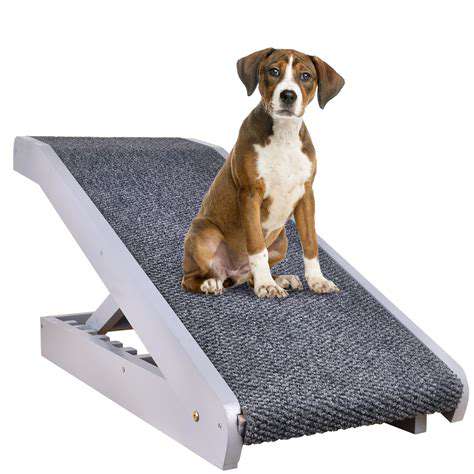Cat Litter Box Solutions: Solving Accidents
Optimal Litter Box Placement for Convenience
A well-placed litter box is crucial for a happy and healthy cat. Choosing a location that's convenient for your feline friend, but also conducive to their natural instincts, is key to litter box success. Cats are creatures of habit and appreciate a consistent, easily accessible space. Avoid placing the box in high-traffic areas or near food and water bowls, as this can deter your cat from using it. Consider the cat's natural inclination to bury their waste, and provide a quiet, secluded corner as the ideal spot.
Think about your cat's usual movement patterns. Where do they frequently roam and rest? Positioning the litter box near their favorite napping spots or play areas can encourage them to use it more readily. A location that's easily accessible from multiple parts of the house can also simplify the process for your cat.
Litter Box Placement & Litter Type Considerations
The type of litter you choose can also influence the ideal placement of the box. For example, if you use a clumping litter, you might want to position it closer to a cleaning station. This allows for easier disposal of clumps and minimizes the potential for mess throughout the house. Alternatively, if you use a non-clumping litter, you might want to position the box in a location that's a little more convenient for scooping the entire litter box contents.
Consider the size and shape of the litter box as well. A larger litter box will allow your cat more room to comfortably use the box. A smaller box may be suitable for a single cat, but may not accommodate multiple cats, especially if they have differing preferences.
Accessibility and Privacy for Your Cat
Cats value privacy and accessibility when using the litter box. Avoid placing the litter box in a direct line of sight from high-traffic areas or other frequently used zones in your home. Choose a location that provides a sense of seclusion and security for your feline friend. A corner or a space behind a piece of furniture can be ideal choices.
Ensure the litter box is easily accessible for your cat. The box shouldn't be obstructed by furniture or other items. Your cat should be able to approach and enter the box without any difficulty. This is particularly important for senior cats or cats with mobility issues.
Multiple Cats and Litter Box Strategies
If you have multiple cats, providing multiple litter boxes is crucial for minimizing conflict and ensuring everyone has their own space. The general rule of thumb is to provide one more litter box than the number of cats you have. This allows each cat to have a private space and reduces the likelihood of competing for use of the same area.
Consider the location of each litter box, ensuring that they are strategically spaced throughout the house. This allows your cats to use the litter boxes with minimal disturbance from other cats. Pay close attention to the cat's behaviors and their preferences for individual locations. This allows for each cat to be comfortable.
Cleaning and Maintenance for Optimal Use
Regular cleaning and maintenance of the litter box are vital for maintaining a clean environment and preventing odors. A clean litter box is essential for encouraging your cat to use it consistently. Daily scooping of waste is recommended, and a thorough cleaning of the entire box at least once a week is crucial. This will minimize unpleasant smells and maintain a hygienic environment.
Using appropriate litter and employing good cleaning practices can significantly improve the overall experience for your cat and make litter box placement less problematic. This will help create a less stressful and more comfortable experience for your cat, improving their overall well-being.

Addressing Litter Box Hygiene: Maintaining a Clean Environment
Choosing the Right Litter Box
Selecting the appropriate litter box is crucial for maintaining a clean environment and a happy cat. Consider your cat's size and preferences when making your choice. A litter box that's too small can lead to discomfort and potential issues with litter box hygiene. A spacious box, however, can encourage your cat to use it comfortably. Different shapes and materials are available, so explore the options to find one that best fits your cat's needs and your home's aesthetic. The ideal litter box should allow your feline friend to comfortably turn around and bury their waste without feeling cramped.
Think about the placement of the litter box. A convenient location, easily accessible to your cat, will encourage consistent use. Avoid placing it near food or water bowls, as this can sometimes deter your cat from using it. A quiet, secluded area that provides a sense of privacy is often a good choice. The location is key to maintaining a clean and usable litter box.
Litter Type and Frequency
The type of litter you use significantly impacts litter box hygiene. Some cats prefer clumping litter, which is easier to scoop and maintain a clean box. Other cats might prefer non-clumping litter, which can be a good option for cats with certain health conditions. Experiment with different types to see what your cat prefers. Regardless of the type, ensure that you're scooping the litter box regularly to remove waste and maintain a clean environment for your cat.
The frequency of changing the litter depends on the type of litter and the number of cats using the box. With clumping litter, you can remove soiled portions more frequently, which will keep the box clean. However, with non-clumping litter, you may need to change the entire litter box more often to maintain good hygiene. Understanding the specific needs of your cat and the chosen litter will help you establish the optimal schedule for keeping the litter box clean.
Litter Box Location and Placement
Strategic placement of the litter box is vital to maintaining a clean environment and encouraging your cat to use it. Avoid placing the box in high-traffic areas or near noisy appliances. A quiet, secluded location that provides a sense of privacy is often preferred by cats. Consider the location of other household items, such as food and water bowls, when choosing the placement for the litter box. This will minimize any potential conflicts or deterrents from the litter box area.
Ensure the area around the litter box is easily accessible to your cat. A clear path to and from the box is crucial for encouraging consistent use. A clutter-free environment around the litter box will contribute to a more positive experience for your cat, promoting cleanliness and hygiene.
Cleaning and Maintenance
Regular cleaning and maintenance are essential for maintaining good litter box hygiene. Scoop the litter box at least once a day, removing any waste promptly. This helps to prevent the spread of odor and bacteria, keeping the box clean and fresh for your cat. Thorough cleaning of the litter box itself, including the sides and base, should be done at least once a week or more frequently depending on the type of litter and the number of cats using it. This will maintain a sanitary environment for your cat.
Using appropriate cleaning supplies is also important. Avoid harsh chemicals that could irritate your cat's skin or respiratory system. Choose gentle, pet-safe cleaners to ensure a safe and clean environment for your cat. A clean and well-maintained litter box is crucial for maintaining a healthy and happy feline companion.
Preventing Litter Box Issues
Addressing litter box issues early on is crucial for maintaining a healthy and happy cat. If your cat has stopped using the litter box, there could be underlying health problems, such as urinary tract infections. Consult your veterinarian to rule out any medical reasons for the issue. A change in litter type or box design might also be necessary to address behavioral issues. Pay attention to the signs and address them promptly to maintain a clean environment and prevent future issues.
Changes in the cat's routine or environment can also affect litter box habits. Stress factors, such as moving or the addition of a new pet, can lead to litter box aversion. Creating a calm and predictable environment will support healthy litter box habits and contribute to a clean home environment.
Read more about Cat Litter Box Solutions: Solving Accidents
Hot Recommendations
- Best Pet Bowls: Stainless Steel and Ceramic
- Pet Hydration: Why It's Crucial
- Stop Counter Surfing: Training Your Dog to Stay Off
- Pet Hypothyroidism: Symptoms and Management
- Signs of Pet Liver Disease: What to Watch For
- Pet Emergency Kits: What to Pack
- Dangers of Xylitol: Toxic to Dogs
- Dealing with Pet Diarrhea: When to See a Vet
- Preparing Pets for Travel: Tips for a Smooth Trip
- Pet Depression: Recognizing the Signs











